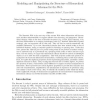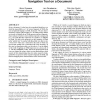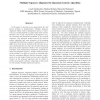125 search results - page 23 / 25 » Using XML Trees to Represent GUI States |
IJCAI
2007
13 years 9 months ago
2007
We introduce an approach to autonomously creating state space abstractions for an online reinforcement learning agent using a relational representation. Our approach uses a tree-b...
ISCI
2008
13 years 7 months ago
2008
The Semantic Web is the next step of the current Web where information will become more machine-understandable to support effective data discovery and integration. Hierarchical sc...
ICAIL
2005
ACM
14 years 1 months ago
2005
ACM
d on Dung’s [4] abstract argumentation system • arguments: trees of chained defeasible inferences • aim: determine the status of a query given a belief base • incorporation...
PODS
2006
ACM
14 years 7 months ago
2006
ACM
Given a document D in the form of an unordered labeled tree, we study the expressibility on D of various fragments of XPath, the core navigational language on XML documents. We gi...
IPPS
2006
IEEE
14 years 1 months ago
2006
IEEE
In this paper we describe a new approach for the well known problem in bioinformatics: Multiple Sequence Alignment (MSA). MSA is fundamental task as it represents an essential pla...



